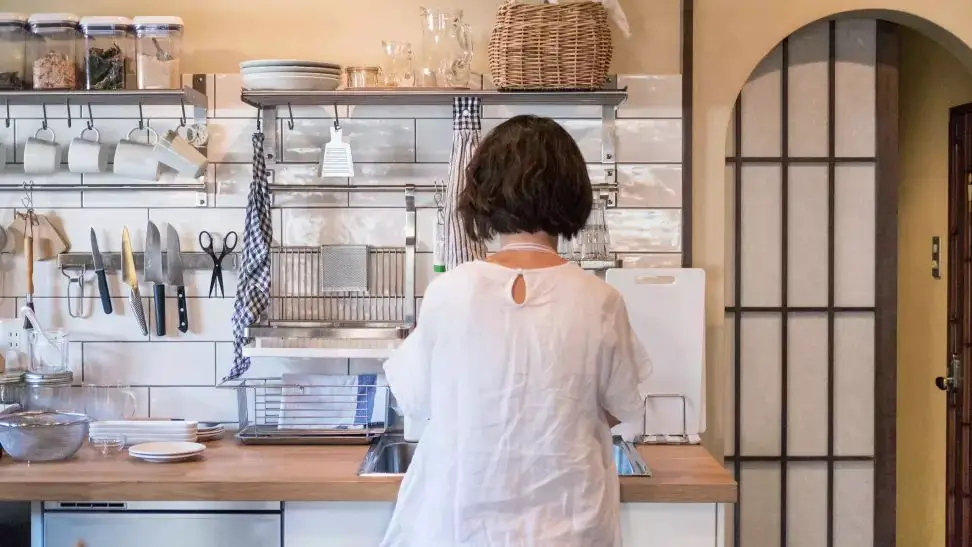Concerns about plastic pollution have sparked a growing interest in reducing plastic use, especially in everyday settings like the kitchen. With an estimated 8 million metric tons of plastic and toxic chemicals entering our oceans each year, it’s crucial to address this issue at home.
From simple swaps like using reusable containers instead of plastic bags and embracing sustainable alternatives for food storage, there are numerous strategies that can significantly cut down on single-use plastics. Whether you’re a seasoned environmental enthusiast or just starting on your sustainability journey, these tips will help you make a positive impact while creating a more eco-friendly kitchen environment.
Key Takeaways
- Embrace sustainable food storage options like glass containers and silicone bags to reduce reliance on single-use plastic bags and wraps.
- Opt for reusable kitchen items such as stainless steel straws, bamboo utensils, and cloth napkins to minimize the use of disposable plastic products.
- Implement waste reduction strategies like composting organic waste and repurposing plastic containers for storage to minimize overall kitchen waste.
- Choose eco-friendly practices such as using refillable soap dispensers, making homemade cleaning products, and avoiding disposable plastic cutlery for a more sustainable kitchen.
- Adopt sustainable shopping habits by purchasing products with minimal packaging, choosing bulk items, and seeking out plastic-free alternatives to reduce plastic consumption in the kitchen.
- Transition to a plastic-free lifestyle by gradually replacing plastic items with sustainable alternatives, being mindful of packaging waste, and embracing a more eco-conscious approach to daily living.
Understanding Plastic Impact
Kitchen Pollution
Plastic waste in the kitchen significantly contributes to environmental pollution. Single-use plastic items, such as straws, utensils, and bags, are major sources of kitchen pollution. Improper disposal of these products further exacerbates the issue by clogging waterways and harming wildlife.
Reducing plastic use in the kitchen is crucial for minimizing this type of pollution. By opting for reusable alternatives like metal or bamboo utensils, glass containers, and silicone food storage bags, households can dramatically cut down on their contribution to kitchen pollution.
Health Concerns
Plastic containers used for storing or heating food may leach harmful chemicals into what we eat. When exposed to heat, plastics can release toxins linked to various health issues such as hormonal imbalances and certain types of cancers.
Minimizing plastic use in the kitchen is an effective way to reduce exposure to potential health risks associated with plastic consumption. For instance, using stainless steel or glass containers instead of plastic ones for storing leftovers can help prevent harmful chemicals from seeping into our food.
Switching from single-use plastic wrap to beeswax wraps offers a sustainable alternative that eliminates the need for disposable cling film while keeping food fresh. Replacing plastic scrubbers with biodegradable options like loofah sponges and tea helps reduce microplastic contamination in dishwashing activities.
Sustainable Food Storage
Reusable Containers
Switching to reusable containers is an effective way to reduce plastic use in the kitchen. By opting for durable, reusable containers, you can significantly decrease reliance on single-use plastics. These containers not only help in minimizing kitchen waste but also promote sustainability in the kitchen. For example, using stainless steel or glass food storage containers instead of disposable plastic ones can make a substantial difference.
By choosing reusable containers, you contribute to reducing the environmental impact of plastic pollution. This simple switch aligns with sustainable living practices and encourages mindful consumption habits. It’s a small change that can lead to significant positive outcomes for the environment and future generations.
Beeswax Wraps
Another alternative to plastic wrap is beeswax wraps. These wraps offer a sustainable option for preserving food without relying on traditional plastic wrap. Not only are beeswax wraps eco-friendly and biodegradable, but they also help eliminate the need for disposable plastic wrap altogether.
By incorporating beeswax wraps into your kitchen routine, you actively participate in reducing single-use plastics’ detrimental effects on the environment. The versatility and reusability of beeswax wraps make them an excellent choice for environmentally conscious individuals seeking practical solutions to minimize their ecological footprint.
Glass Jars
Repurposing glass jars provides a non-toxic and sustainable alternative to conventional plastic storage containers commonly used in kitchens. By reusing glass jars from items like sauces or condiments, you minimize reliance on single-use plastic packaging while embracing an environmentally friendly approach to food storage.
In addition to being aesthetically pleasing and versatile, glass jars contribute positively towards reducing overall household waste generation associated with disposable plastics usage. Moreover, utilizing glass jars promotes safe food storage while supporting eco-conscious lifestyle choices.
Reusable Kitchen Items
Cloth Napkins
Cloth napkins are a fantastic way to reduce paper waste in the kitchen. By using cloth napkins instead of paper towels, you can significantly cut down on the amount of disposable paper products that end up in landfills. Not only are cloth napkins environmentally friendly, but they also add a touch of elegance to your dining table.
Switching to cloth napkins is an excellent choice for those looking to adopt a more sustainable lifestyle. They contribute to reducing deforestation and water consumption associated with paper towel production. By investing in reusable cloth napkins, you can save money in the long run as they can be laundered and used repeatedly.
Silicone Lids
Silicone lids offer an eco-friendly alternative to plastic wrap. These durable and versatile lids come in various sizes and shapes, making them suitable for different types of containers. By choosing silicone lids over single-use plastic wraps, you not only reduce your reliance on disposable plastics but also minimize exposure to harmful chemicals commonly found in plastic wrap.
Silicone lids are designed for multiple uses and are heat-resistant, microwave-safe, and dishwasher-friendly. This makes them convenient for everyday use while being mindful of our environmental impact. Moreover, these innovative kitchen accessories help maintain the freshness of food without contributing to plastic pollution.
Strategies for Waste Reduction
Composting
Composting is a fantastic way to reduce plastic use in the kitchen. By composting organic waste, such as fruit and vegetable scraps, you can significantly decrease the amount of plastic trash generated in your kitchen. Instead of throwing these items away in a plastic garbage bag, they can be repurposed into nutrient-rich soil for gardening. This means less reliance on plastic bags for waste disposal.
Implementing composting practices not only benefits the environment by reducing greenhouse gas emissions but also minimizes the need for single-use plastics like garbage bags. When organic waste is diverted from landfills through composting, it contributes to reducing overall kitchen waste, including plastics. For example, eggshells and coffee grounds that would typically end up in a landfill are now being transformed into valuable resources.
Composting doesn’t just help with managing food waste; it also plays a significant role in reducing plastic use throughout your home. The more you compost, the fewer trash bags you’ll need to buy and use—ultimately cutting down on your household’s consumption of plastic materials.
Recycling Rules
Understanding local recycling rules is essential when aiming to reduce plastic use in your kitchen effectively. Different municipalities have varying guidelines for recycling different types of plastics and other materials commonly found in kitchens.
Adhering to these regulations ensures that plastics are recycled effectively rather than ending up as non-biodegradable waste polluting our planet or clogging landfills indefinitely. By separating recyclable items from general trash according to local requirements, you’re contributing directly to minimizing improper disposal of plastics.
For instance, some areas may accept certain types of packaging materials while others don’t; knowing this information helps prevent contamination during recycling processes. Familiarizing yourself with what can and cannot be recycled reduces confusion about which items should go where—increasing the likelihood that all recyclable plastics will reach their intended destination instead of being discarded improperly.
Minimizing Single-Use Plastic
Shopping Bags
One effective strategy is to switch from single-use plastic shopping bags to reusable shopping bags. By opting for fabric or tote bags, you can significantly decrease your reliance on disposable plastics. Reusable shopping bags not only help minimize plastic waste but also support sustainable efforts by reducing the accumulation of plastic shopping bags.
Choosing reusable shopping bags over single-use plastic ones is a simple yet impactful step towards reducing plastic consumption in your kitchen. These reusable alternatives are durable, versatile, and environmentally friendly. With just a small investment in reusable shopping bags, you can make a big difference in decreasing the amount of plastic waste generated from grocery trips.
Water Bottles
Another way to cut down on plastic use in the kitchen is by switching to refillable water bottles instead of relying on single-use plastic bottles. Utilizing refillable water bottles helps eliminate the need for disposable plastics and reduces overall plastic consumption at home. By choosing water bottles made from sustainable materials, such as stainless steel or glass, you can further lessen your reliance on traditional disposable plastics.
Opting for refillable water bottles offers numerous benefits beyond reducing plastic waste. Not only do these eco-friendly alternatives contribute to minimizing environmental impact, but they also promote healthier hydration habits by encouraging regular refills with fresh drinking water. Using refillable water bottles saves money that would otherwise be spent on purchasing single-use bottled beverages.
Eco-Friendly Practices
Energy Efficiency
Investing in energy-efficient appliances is crucial for reducing the environmental footprint of your kitchen. By using less energy, these appliances indirectly contribute to minimizing plastic use. For instance, a refrigerator with an excellent energy rating consumes less power, which aligns with sustainable practices that reduce reliance on plastics. Opting for energy-efficient cooking equipment such as induction cooktops or convection ovens can further support efforts to minimize plastic usage in the kitchen.
Conserving water in the kitchen plays a significant role in reducing overall environmental impact, including plastics. Implementing simple measures like fixing leaky faucets and using dishwashers only when fully loaded can significantly contribute to water conservation and indirectly aid in minimizing plastic use. For example, by conserving water during food preparation and cleaning processes, you are supporting sustainability efforts that encompass reducing plastic use.
Bulk Buying
One effective strategy is to opt for bulk buying of groceries and household items. Purchasing products like rice, pasta, cereals, spices, and cleaning supplies from bulk bins or larger packages reduces the need for individually packaged items that often come wrapped in plastic. By buying in bulk quantities whenever possible, you can cut down on excessive packaging materials such as single-use plastics commonly found in smaller-sized products.
In addition to bulk buying groceries and household essentials at stores offering package-free options or refill stations helps minimize unnecessary packaging waste while also promoting environmentally friendly shopping habits.
Local Produce
Choosing locally sourced produce not only supports local farmers but also contributes to reducing your reliance on plastics within the kitchen. When you purchase fruits and vegetables from nearby farms or farmer’s markets instead of supermarkets where they are often packaged in single-use plastics like bags or containers; you actively participate in decreasing overall environmental impact including plastics within your household consumption.
Opting for local produce means fewer resources used for transportation and storage since they haven’t traveled long distances nor required extensive packaging materials before reaching your table.
Sustainable Shopping Habits
Bulk Buying
Bulk buying is a great option. Purchasing items like rice, pasta, grains, and spices in bulk helps minimize packaging waste. By opting for larger quantities of these staples, you can significantly cut down on the amount of plastic packaging that ends up in landfills or oceans. When you buy in bulk, you often save money as well.
Bulk buying also allows you to use reusable containers for storage instead of relying on single-use plastic bags or containers. This not only reduces your plastic consumption but also keeps your kitchen organized and eco-friendly. For example, storing flour or sugar in glass jars not only looks aesthetically pleasing but also contributes to environmental sustainability.
Another benefit of purchasing items in bulk is the reduction of transportation-related emissions since fewer trips are needed to restock supplies. This means that by embracing this sustainable shopping habit, individuals can contribute towards reducing their carbon footprint.
Metal Straws
In addition to making conscious choices about food purchases and storage solutions, using metal straws is an effective way to reduce plastic use in the kitchen. Opting for metal straws over disposable ones decreases reliance on single-use plastics such as traditional plastic straws which end up polluting water bodies and harming marine life.
Metal straws are durable and reusable alternatives that help combat the detrimental impact of single-use plastics on the environment while still allowing individuals to enjoy their favorite beverages without contributing to environmental degradation.
Moreover, metal straws come with cleaning brushes that make them easy to maintain and keep hygienic after each use. They are also available in different sizes suitable for various types of drinks including smoothies and cocktails.
Local Produce
Choosing locally sourced produce plays a significant role in reducing plastic usage within kitchens. When people opt for local produce, they support farmers who tend to have more sustainable farming practices than large-scale industrial agriculture operations which often rely heavily on single-use plastics for packaging purposes.
Plastic-Free Alternatives
Metal Straws
Metal straws are a fantastic alternative. These reusable straws are durable and can be used for both hot and cold beverages. By using metal straws, you can significantly cut down on the number of disposable plastic straws that end up in landfills and oceans. They are easy to clean and come in various sizes to accommodate different drink types.
Switching to metal straws is an excellent way to make a positive impact on the environment while enjoying your favorite beverages. You can carry them with you wherever you go, whether it’s for a refreshing iced coffee or a smoothie after a workout session.
Loose Vegetables
Opting for loose vegetables at the grocery store instead of pre-packaged ones is another effective method for reducing plastic use in the kitchen. Many fruits and vegetables come wrapped in unnecessary plastic packaging, contributing to environmental pollution. By choosing loose produce, you not only eliminate this excess waste but also have more control over the quantity you purchase, which helps reduce food waste.
When shopping for loose vegetables, bring your own reusable produce bags or simply place them directly into your shopping cart without any additional packaging. This small change makes a significant difference by decreasing single-use plastics that often end up polluting our planet.
Wooden Utensils
In addition to metal straws and loose vegetables, wooden utensils offer an eco-friendly alternative when striving to reduce plastic use in the kitchen. Wooden spatulas, spoons, and forks are biodegradable and sustainable options compared to their plastic counterparts. They are ideal for cooking as they do not scratch cookware surfaces like metal utensils might.
Using wooden utensils is not only environmentally friendly but also adds a natural aesthetic appeal to your kitchen space. Plus, they’re easy to clean and maintain—a simple wash with mild soap will keep them ready for reuse time after time.
Package-Free Shops
Exploring package-free shops is an innovative way of minimizing reliance on plastics in the kitchen. These stores allow customers to bring their own containers or bags when purchasing items such as grains, spices, oils, soaps,and cleaning products—eliminating the need for disposable packaging altogether.
Reducing Packaging Waste
Loose Vegetables
Opting for loose vegetables is a great way to minimize packaging waste. By choosing fresh produce without plastic wrapping, you can significantly cut down on the amount of single-use plastics used in your kitchen. For instance, instead of purchasing pre-packaged salad greens or pre-cut fruits packaged in plastic containers, consider selecting loose lettuce and whole fruits and vegetables.
Loose vegetables not only help reduce plastic waste but also often come with less overall packaging. When shopping for loose vegetables, think about how you can incorporate them into your meals while minimizing waste. Buying from local farmers’ markets or joining community-supported agriculture (CSA) programs can provide access to a variety of fresh produce without excessive packaging.
Mindset Shift
Making a mindset shift towards reducing plastic use in the kitchen involves reevaluating our consumption habits and being more mindful about the products we bring into our homes. It’s essential to recognize that small changes in our purchasing decisions can have a significant impact on reducing plastic waste. For example, when grocery shopping, consider whether certain items could be purchased with minimal or no packaging.
By adopting a mindset focused on sustainability and environmental consciousness, individuals can proactively seek out alternatives to single-use plastics when considering their kitchen purchases. This might involve exploring different stores or suppliers that offer package-free options for common household items like pantry staples and condiments.
Package-Free Shops
Embracing the concept of package-free shops is another effective strategy for minimizing plastic use in the kitchen. These establishments are dedicated to providing consumers with everyday goods such as grains, nuts, spices, oils, and cleaning products without disposable packaging materials like bottles or bags made from conventional plastics.
Package-free shops allow customers to bring their own reusable containers such as glass jars or cloth bags to fill up with desired quantities of various items without contributing additional waste from unnecessary product packaging. By supporting these businesses and incorporating their offerings into daily routines at home, individuals can actively contribute to reducing overall reliance on single-use plastics within their households.
Community Engagement
Engaging with one’s community plays an important role in promoting sustainable practices aimed at reducing plastic usage within kitchens.
Embracing Plastic-Free Living
Mindset Shift
Making a conscious effort to reduce plastic use in the kitchen starts with a mindset shift. It’s about being aware of the impact of plastic on the environment and taking small steps to minimize its usage. One way to initiate this shift is by reevaluating our shopping habits. Instead of reaching for products packaged in plastic, opt for items that come in glass, metal, or cardboard packaging. By doing so, you’re already contributing to reducing the demand for plastic packaging.
Moreover, embracing a plastic-free lifestyle involves being mindful of single-use plastics such as straws, utensils, and food storage bags. Switching to reusable alternatives like stainless steel straws, bamboo utensils, and silicone food storage bags can significantly cut down on daily plastic consumption. These simple swaps not only reduce waste but also inspire others around you to follow suit.
Another crucial aspect of this mindset shift is understanding that every small change matters. Even if it seems insignificant at first glance, every decision to opt for a non-plastic alternative adds up collectively and makes a meaningful difference in curbing plastic pollution.
Community Engagement
Engaging with your community plays an integral role in promoting plastic reduction efforts within your social circle and beyond. Start by sharing your journey towards using less plastic with friends and family members; lead by example through practical demonstrations such as bringing reusable containers when buying groceries or hosting eco-friendly gatherings where single-use plastics are noticeably absent.
Furthermore, consider organizing or participating in local initiatives aimed at raising awareness about reducing plastic use in households and communities. This could involve collaborating with neighborhood associations or environmental organizations to host workshops on sustainable living practices specifically tailored for kitchens.
Closing Thoughts
Congratulations on taking the first steps towards reducing plastic use in your kitchen! By understanding the impact of plastic, embracing sustainable alternatives, and adopting eco-friendly practices, you are actively contributing to a healthier planet. Small changes, like opting for reusable kitchen items and minimizing single-use plastic, add up to make a significant difference. Remember, it’s not about being perfect; it’s about making progress. So, keep exploring plastic-free living and sustainable shopping habits. Every choice you make shapes a better future for our environment.
Now that you have the tools and knowledge, it’s time to put them into action. Start by implementing one change at a time and gradually incorporate more sustainable practices into your daily routine. Share your journey with others and inspire them to join the movement towards reducing plastic use in the kitchen. Together, we can create a lasting impact for generations to come.
Frequently Asked Questions
How does plastic impact the environment?
Plastic pollution harms wildlife, ecosystems, and human health. It contributes to ocean pollution, endangers marine life, and disrupts food chains. By reducing plastic use in the kitchen, we can help mitigate these detrimental effects.
What are some sustainable food storage options?
Opt for glass containers, stainless steel lunch boxes, or silicone bags instead of single-use plastic bags or cling wrap. These alternatives are durable, reusable, and better for the environment.
How can I minimize single-use plastic in my kitchen?
Choose reusable items like metal straws, bamboo utensils, and cloth produce bags. Buy products with minimal packaging to reduce your overall plastic waste.
What are eco-friendly shopping habits for a sustainable kitchen?
Shop at bulk stores using your own containers to avoid excessive packaging. Look for products with minimal or recyclable packaging and support brands that prioritize sustainability.
How do I embrace a plastic-free lifestyle in the kitchen?
Transition gradually by swapping out disposable plastics with long-lasting alternatives such as metal or glass containers. Small changes add up to make a significant impact on reducing plastic use in your daily life.






